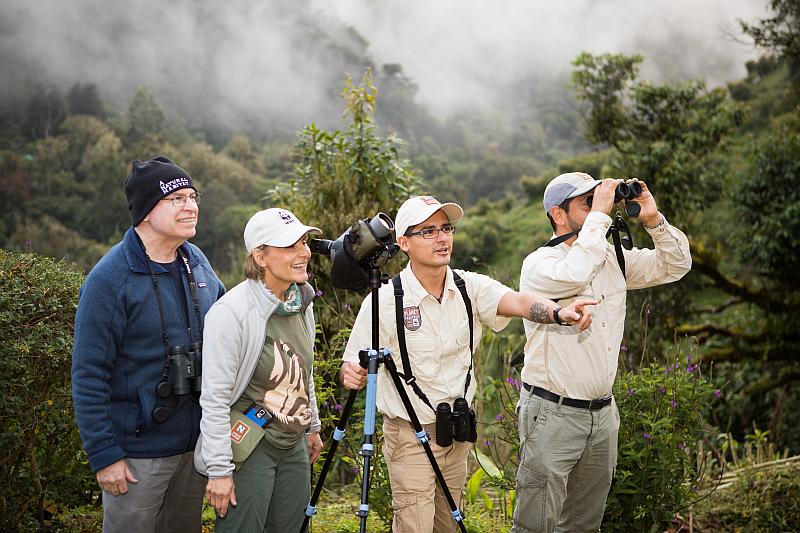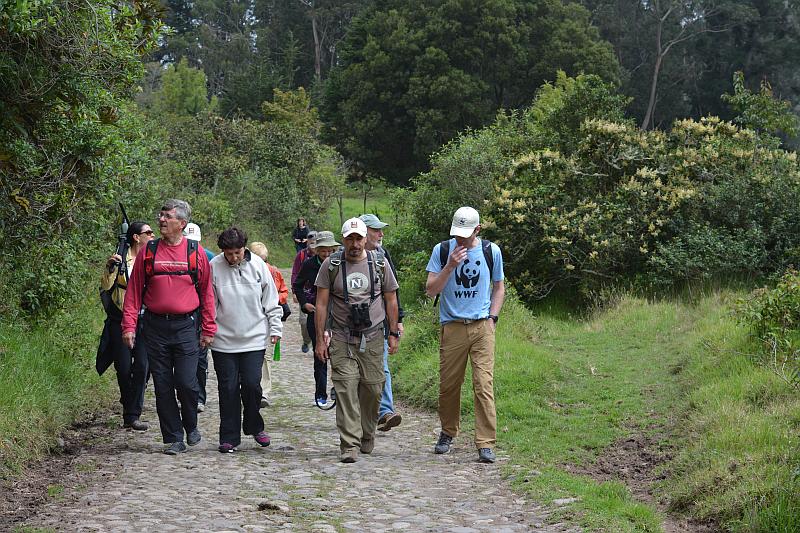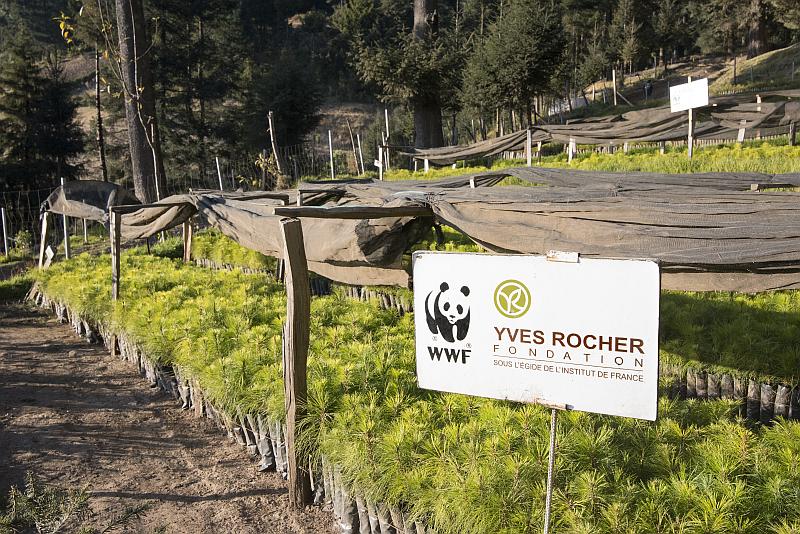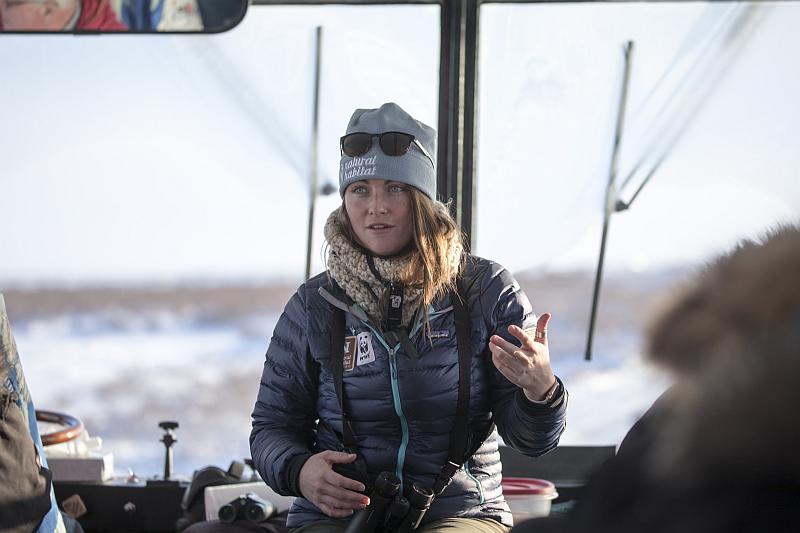What is your partnership model? When and why did you begin your impact tourism program?
Prior to 2014, Natural Habitat Adventures (Nat Hab) was one of several tour operators with whom World Wildlife Fund (WWF-US) partnered to market and operate its member travel program, a commonplace in the affinity travel industry. Starting in 2014, WWF selected Nat Hab to exclusively market and operate their member travel program. Nat Hab was chosen because they are one of the only tour operators specifically focused on wildlife and natural history. More importantly, however, Nat Hab shares a strong commitment to conservation travel and WWF’s mission – to conserve nature and reduce the most pressing threats to the diversity of life on Earth, with the vision to build a future in which people live in harmony with nature.
By 2019 Nat Hab operated around 700 member trips for WWF per year, which are open to the public, but about 30 percent are filled by past and current WWF supporters. In addition to member trips, WWF and Nat Hab work together to plan an additional 7 to 10 special trips for WWF’s higher-level donors. These trips are accompanied by field experts and give the travelers a more exclusive and immersive behind-the-scenes experience.

Please provide brief examples of some of your most impactful projects.
With WWF resources, endorsement, and reputation, Nat Hab is seen as a trusted source for quality travel experiences that are operated in the most responsible and sustainable means possible. As an example of this, last summer WWF and Nat Hab joined forces to design the world’s first zero-waste group tours. With input from WWF’s food waste and sustainable packaging experts, 14 travelers joined this pioneering endeavor to Yellowstone National Park in which Nat Hab’s goal was to divert (refuse, recycle, compost, upcycle, or re-use) 99 percent or more of all waste produced as part of Nat Hab-sponsored trip operations. It was a valuable learning experience, and Natural Habitat Adventures will work to incorporate the lessons learned into its future trips and contribute best practices to the rest of the industry.
Has your impact tourism program helped, hurt, or had no impact on your business?
This partnership has had an enormous positive impact for both parties. The number of Nat Hab/WWF travelers had doubled in just five years. WWF can run its member travel program much more efficiently by partnering with a single operator and provide greater consistency and quality across all trips.
Vetting Process
How do you select projects? What is the structure to ensure ongoing accountability?
The funds that Nat Hab provides to support WWF’s mission are unrestricted and distributed across many WWF programs and goals. WWF’s experts and leadership selects projects to determine where the funds can have the most impact. WWF’s six goals guide much of what we do (food, oceans, forests, freshwater, wildlife & climate), though it is up to country offices and program experts to select priority projects.
To ensure ongoing accountability, WWF is a well-respected nonprofit organization and deeply values the trust that has been placed in them. Partners trust us to carry out joint projects; governments and private entities trust our science and ability to create solutions that serve nature and people; and donors trust us to use their funds to advance conservation. To safeguard this critical trust, WWF is committed to best practices in governance, accountability, and transparency. This commitment exists at all levels of the organization.
For example, to address the issue of underfunded and poorly managed protected areas, WWF works with government leaders, public and private sector donors, NGOs, and others to securing funding that is used to cover expenses related to properly managing conservation areas, which includes protected areas, community lands and other types of land designated for sustainable use or no development. Funds are allocated to buy boats that are used to patrol coastlines to look for people fishing illegally or to buy drones that are used to spot wildfires. Funds also are used to convene workshops to teach people about sustainable tourism opportunities in or near protected areas.
Employee Engagement
How are your employees and your company involved in the projects? Have you provided staff training to support your impact tourism program?
As part of the partnership, Nat Hab provides over 20 opportunities annually for key WWF staff to join their trips. This gives WWF staff a first-hand look at the travel program and can also provide other travelers great insight on WWF work, both globally and in the destinations. The staff and guests greatly appreciate these opportunities, but it is by no means seen as a holiday for staff. Staff reps are expected to present on WWF’s work, evaluate the program and provide stories about their experience. Every staff representative is provided a manual and attends a pre-departure briefing to prepare for the experience.
Nat Hab Expedition Leaders (EL) also gain useful, firsthand information about WWF’s work when traveling with WWF staff reps that can be shared with future travelers. Where there is a personal connection between EL and WWF staff, it empowers EL to discuss WWF in a more natural and narrative way. WWF also provided online resources, webinars and has experts join the annual training for Expedition Leaders and guides. Through post-trip evaluations, we are pleased to see how well these trainings and resources work because travelers often mention how the experience and EL’s enthusiasm for WWF gives them great confidence in the work we do.

Funding Model
How are funds raised and distributed? Are donations tax deductible? To date, how much has been raised?
As a company, Nat Hab annually contributes over $130,000 annually, plus one percent of gross tour revenue in support of WWF’s mission. Therefore, with one percent of tour revenue going to support WWF, travelers are already making an impact just by traveling. In 2019, Nat Hab provided over $800,000 in support of WWF’s work through their company funding model.
There is no direct fundraising on the trips, but each trip has a communications strategy centered around traveler’s philanthropy to deliver key messages before, during and after the trips. This strategy was designed by Sam Ham PhD, a respected expert and professor emeritus of communication psychology and conservation social sciences at the University of Idaho.
For travelers who want to support the mission further, after each trip every traveler can donate $250 to WWF and receive $250 or $500 off a future Nat Hab trip, depending on when the book their next trip. This strategy brings in another $90,000 per year in support of WWF’s mission. This gift is not tax deductible because the travelers receive goods and services equal to or exceeding the amount of the gift. However, any gifts outside of the $250 promotion may be tax deductible, but we always suggest checking with an accountant. In total, including the funds raised from this $250 strategy, travelers alone provide around $2,000,000 per year to support WWF’s mission.
Do project funds go into a separate account or to a foundation to ensure transparency and separation from business revenue?
These funds are part of WWF’s annual unrestricted revenue, which get distributed across WWF’s programs and administrative costs. WWF has a reputation and commitment to use funds in a most responsible and transparent ways possible.
Visitor Engagement
Do travelers visit the project sites? Why or why not?
Site visits depend on the destination, access to sites and the trip. Often the places with amazing wildlife, scenery, and good accommodations and infrastructure for travelers are not the same places WWF can make the biggest impact and do its most important work. Since we work with migratory species and across land and seascapes, for example, our work is typically not confined to one “site”, which makes visitation difficult for our standard trips. We also largely do our work through partners and people on the ground, so we need to be mindful of our ultimate goal for many of these projects, which is to run sustainability and independently.
However, site visits are usually included with the special higher-level donor trips. This may include visit with a local office, community or partners and special access to a park headquarters, for example. In these special cases, it very important to give credit to the communities and local NGOs doing the work on the ground.
Alternatively, Nat Hab also contributes to a handful of smaller, grassroots projects that may not be affiliated with WWF, but take place in the areas we run trips. For instance, Nat Hab may purchase a commercial sewing machine for a women’s cooperative in Uganda, or help a school in Madagascar safely remove a bat colony from its roof. Small, directed projects where a little money goes a long way.

Do you offer opportunities for voluntourism and/or material donations? Why or why not?
We have participated in some small-scale activities such as litter collection and citizen science monitoring programs, however our trips do not actively offer opportunities voluntourism or material donations; we have found that it tends to be difficult to do well consistently. Working with wildlife can be dangerous and take some training, often in the range of 2-6 weeks prior to actually volunteering, so we don’t encourage voluntourism because of the natural constraints this causes.
In terms of material donations, Nat Hab may provide items to support communities, as mentioned above, but travelers are not encouraged to bring gifts. Although they have the best intentions, it is difficult for travelers to know in advance what is needed and appropriate to bring. When visiting a community, since the host is sharing their time and cultural assets, they should be financially compensated fairly so they can determine what they need with revenue from the services they provide. This also helps they develop and have control over their own sustainable business model.
What type of educational opportunities and/or materials do you give to travelers?
To educate travelers, information on WWF works is woven into the entire experience. Expedition Leaders are trained to share information about WWF’s work globally and in the destination. Pre-trip materials include descriptions of the work being carried out. Expedition Leaders appreciate the affiliation with WWF because they understand how the work protects the places they cherish and depends on for their own livelihoods.

Community Perspectives
How do you ensure that your values and approach align with those of the community supported? How are you ensuring that your projects meet the most relevant needs of the community?
Around the world, WWF works directly with people to support community management of natural resources and to protect those resources against emerging threats. This collaborative conservation is grounded in the benefits nature provides to people—food, fresh water, shelter, and more—and the role of Indigenous people and local communities as stewards of their own lands.
The role of tourism, and our specific style of Conservation Travel, puts the local communities at the heart of the tourism opportunity. The communities around natural areas are the stakeholders. They serve to gain the most and lose the most, depending on how the tourism industry works within their region. The key to sustainable tourism is to empower them such that they indeed become stakeholders in keeping the natural area and its wildlife, etc.), well, natural. Responsible travel incentivizes communities and destinations to protect their natural and cultural assets. Guests are reminded that just by traveling they are making a positive impact.
Do you engage in ongoing dialogue with the local community? If so, how?
Nat Hab involves local communities in any and all ways possible. Every area they run our trips, in 45+ countries, is quite different in how they currently involve communities with tourism, how receptive they are to expand their operations, and the overall quality provided. But one simple fact is at the forefront, which is that if the local community is not involved, not interested, or not benefiting from tourism, we will not be involved with tourism in that area. Fortunately, local communities can be involved at many levels, so the instances are rare where lack of community representation is a factor.
Has there ever been a time when adjustments to your approach or project have needed to be made as a result of community feedback? Please explain how you were able to adapt.
The most classic example of adapting our approach based on community feedback is largely via the creation of additional employment opportunities in tourism. In “newer” tourism destinations, local communities may not be equipped business knowledge or infrastructure to host in the immersive, educational, and authentic way we wish, so balancing local employment opportunities with traveler expectations and quality standards can be challenging. Thus, Nat Hab focus on the employment and engagement aspects of local communities. In addition to focusing on locals as a key source of hiring, we also work with local partners around the world to help in training such local communities to rise within the tourism industry to gain the skills they need for all levels of the industry.
As an example, with a new destination like Greenland, they may use an expedition leader (EL) from Canada who is supported with local staff and guides, but the goal will be to get the Greenland guides to become ELs when ready. Based on community needs and feedback, they are actively making a steady shift to more involvement in each community we work with in each destination around the planet.
Lessons Learned
Why do you feel your impact tourism program has been so successful?
You cannot love and protect something you do not know. Experiencing the natural landscapes and interacting with local communities firsthand changes a donor’s perspective and caused them to be mindful of conservation both where they live and in the places they visit. The WWF/Nat Hab partnership has been successful because both have well-aligned missions. It is a symbiotic relationship, built on the understanding of how much more can be accomplished as partners.
Although attribution is always complicated, these travel experiences make a measurable impact on travelers’ willingness to support WWF’s work. The average donation to WWF from members who travel is 9 times as high as and non-traveling members. Lifetime giving from members who travel is 16 times as high as and non-traveling members. Traveling members have a 60% retention rate year-to-year compared to 46% of general membership. Our post-trip evaluations are filled with anecdotal comments related to how the trip impacted their perception of WWF. For example:
“We’re long-time supporters of WWF. This trip reinforced the wisdom of being such.” – Botswana, 2019
“Learned of your empowerment of local peoples. Also, you preserve land and nourish it. I would trust my donations to WWF. – Costa Rica, 2019
Why do you feel it is important for the tourism industry to not only promote a product but to provide environmental and community support?
Like any industry, the company needs to protect its product and ensure its long-term sustainability. In tourism, with the product being wildlife and the environment and communities, this is especially critical. Make certain that all activities had a net positive economic, social/cultural and environment impact on the destinations. When considering a new destination, talk to a variety of stakeholders. The lodge owners and local outfitters may tell you that the community embraced tourism, but they have the most to gain. This is especially important when working with indigenous communities.
What challenges has your company faced in developing a successful program?
Unfortunately, we need to embrace the fact that, like all business activities, there are some challenges in being 100% sustainable. One example is greenhouse gas (GHG) emissions. Travel is a carbon-heavy industry, accounting for 8 percent of GHG emissions. These GHG emissions contribute to climate changes in the places we protect and travel. Nat Hab has taken steps to reduce it GHG emissions, but some activities, largely commercial aviation, and cruising, require a means to offset the emissions through carbon credits purchasing until technology provides cleaner alternatives. Nat Hab now includes carbon offsets for the land and international air portions of all their trips.
What would your advice be to another company that is hoping to establish a successful impact tourism program?
Establishing a successful impact tourism program is not a destination, but an ongoing journey. It is like a risk management plan, just because there is a plan in place, there will always be risks and it always needs to be evaluated and can be improved. Assemble a core group to evaluate every part of your program and find ways for continuous improvement. Nat Hab and WWF have a ‘green team’ tasked with identifying new challenges and creative solutions. Don’t be afraid to start and share what you are doing with your travelers. Operators sometimes fear the perception of greenwashing by announcing they are sustainable. Even if you’re not starting off with the most revolutionary, robust, or cutting-edge programs, the goal is to contribute to a worldwide culture of sustainability and conservation, in which every contribution serves the greater good. Be transparent with what you’re doing, and invest in your own expertise when possible. But don’t let the lack of expertise keep doors closed and opportunities unrealized.
Additional Information
For more information contact: Karl Egloff, Karl.Egloff@wwfus.org
Websites: https://www.worldwildlife.org/travel and https://www.nathab.com/
This Impact Tourism Handbook was made possible by generous financial support from Elevate Destinations, Hilton, Holbrook Travel, and Overseas Adventure Travel.
